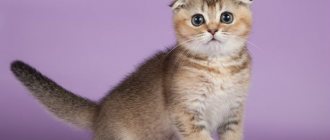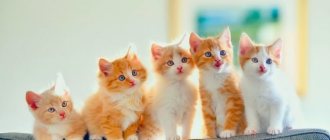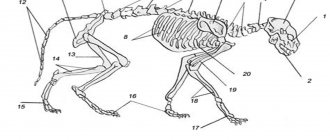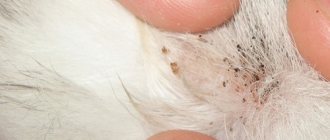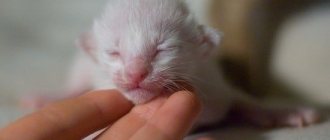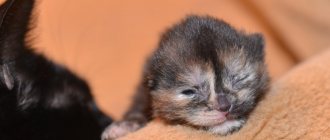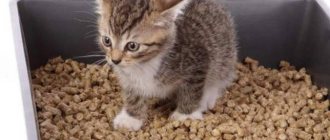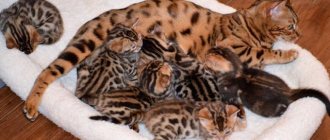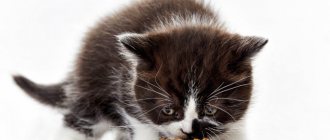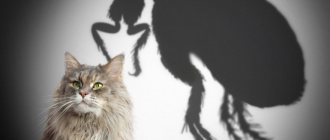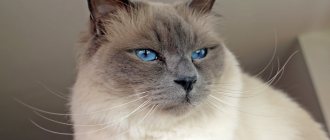Fold kittens
Description of the breed - Scottish Fold kittens
Over the past twenty years, the Scottish Fold has acquired its own, recognizable type, despite crossing with American and British Shorthair cats.
This breed does not have to be massive, with a compact body and short legs, like the British. A distinctive feature is the unusual ears, the fold at the base of which causes the ear to lean forward. The Scottish Fold is a medium-sized cat with a round, well-filled body and short, thick and elastic hair. She has large, round, wide-set eyes with an even color, round, shaggy paws and a short nose with a soft curve in profile.
Animals of this breed come in two types: with hanging ears (folded ears) and straight ears (straight). Fold occurs due to incompleteness of the dominant gene and is the result of a random mutation.
Relatively recently, the ranks of shorthaired folds have been replenished with their semi-longhaired variation, called the Highland Fold. These cats have retained all the characteristic features of the breed, having acquired an elegant, fluffy coat. Highlands have not yet become widespread in Russia, but they are confidently finding their admirers among cat lovers.
The lop ear gene is dominant, but the expressiveness (severity) of its action in kittens, even within the same litter, looks different. They love human society and show it with all their appearance. Scottish cats adapt well to both densely populated apartments full of running children and dogs, and to small spaces. They are not afraid and get along well with other animals.
Scottish Fold kittens are born with normal straight ears. At three to four weeks of age, their ears flatten or remain erect. By twelve weeks it is already possible to determine the quality of the kitten: show, breeding or pet. Only cats with laid ears are show dogs, so getting such kittens is the dream of every breeder.
Photo Fold kittens (click to enlarge):
Photo: Peter Perepelkin, Portlembec, Heikki Siltala
Origin of the Scottish Fold breed
Modern representatives of the Scottish Fold arose as a result of spontaneous mutation. On a Scottish farm in 1961, farmer William Ross noticed a cat whose ears were turned down. She gave birth to two kittens, one of which was purchased by Ross. He registered a white female and began to create a new breed. It became clear that curled ears were a dominant trait.
Scottish fold kittens: description of the breed, photo
The degree of lop-earedness in different animals is completely different and manifests itself regardless of the genotype.
The gene for lop ears is dominant. However, at the very beginning of the development of the Scottish Fold breed, breeders faced serious problems associated with disorders of the musculoskeletal system. Such serious complications led to the fact that in 1971, the largest felinological organization in Europe, GCCF, came to the conclusion that the presence of drooping ears in a cat and similar bone anomalies are directly related. As a result, the breed was banned in its homeland of Scotland and England.
Perhaps, this would be the end of the story of one of the most attractive cats, if some of them had not found a second home in America. Here in Massachusetts, at the Carnivore Science Center, under the leadership of geneticist Neil Todd, the nature of inheritance of the lop-eared gene was studied in detail. Neil found that musculoskeletal disorders in Scottish Folds only occur if the cat's genotype contains a combination of only dominant genes.
Based on this, breeders of this breed were asked to change their breeding programs and stop mating folds with each other. For breeding with folds, it was proposed to use straight cats - cats with ordinary erect ears.
Photo Fold kittens (click to enlarge):
Photo: Brandi.head, tata_aka_T, Kostj
Characteristics of the Scottish Fold
The Scottish Fold has relatively low requirements and does not require special handling. To be happy, he requires a clean environment, plenty of food and, above all, the sympathy of his owners. Scottish Fold cats have a sense of humor and frolic when their owners play and laugh with him. His appearance alone puts anyone in a good mood.
The head of the Scottish Fold cat is well rounded, with a firm chin and well-developed jaws. The muzzle should have noticeable and well-rounded whisker pads. The head smoothly turns into a short, strong neck. The cheeks are well developed, especially in Scottish cats.
Eyes wide open. Large, round, widely set. Eye color generally matches coat color. The Scottish Fold has a wide nose with a slight transition. A small stop is acceptable, but a noticeable stop is considered a fault. The profile is soft, moderately streamlined. The ears are folded forward and down. Small, the smaller the better. Small, well-proportioned ears are preferred. The ears of a fold cat should be set in such a way as to emphasize the rounded skull. The tips of the ears should be rounded.
The body is medium in size, rounded, proportionate at the level of the shoulders and croup. The cat is strong, densely built, but without a hint of fatness or lack of mobility due to short, rough limbs. The feet are very neat and well rounded, with five toes on the front feet and four on the hind feet. Scottish Fold cats can be slightly smaller than male cats. The tail is medium to long, but in proportion to the body.
The Scottish Fold's coat is short, dense, plush, and uniform. Coat texture may vary depending on color or regional and seasonal variations. The length of the coat is medium-long to long. Abundant hair on the face and body is desirable, but short hair is allowed on the face and limbs. “Panties”, tail feathering, tufts of hair between toes and ear feathering should be clearly visible, a collar is desirable. A serious drawback of adult animals is cotton wool.
Photo Fold kittens (click to enlarge):
Photo: Gothicrococo, tata_aka_T, Heha8
Scottish cat colors
All cats are gray at night, but what do they look like during the day? Let's take a closer look at the patterns on the coats of Scottish cats. It would be hard to find two dressed exactly alike. These fashionistas have in their wardrobe much more outfits than the British ones, and there are about two hundred colors, to describe which cattery breeders use mainly English terminology.
black fold-eared Scottish cat We jokingly mention the “outfits” of Scottish cats, since the English word tabby, according to some sources, was first applied to oriental moire fabrics. The literal translation from English is tabby - striped cat. This is the main, so-called “wild” color, characteristic of many wild animals, especially young ones.
The most prominent representative of the cat family with this color is the tiger. That is why this color is called brindle. In English, this color is called mackerel, because to the British it resembles a mackerel fish, or mackerel. A Scottish brindle cat should have an "M" pattern on its forehead, three closed rings in the form of a necklace on its chest, and rings on its legs and tail.
Tabby includes three more colors that come from the main, tabby. If the stripes are interrupted along the length, spots appear. A spotted pattern appears, in English spotted. Ideally, in a spotted pattern, the spots should not merge anywhere to form stripes. The third option for tabby is a marbled pattern, or blotched. In this case, the stripes are not straight, but are intricately bent, forming intricate patterns. This color is also called classic tabby. It allows for a combination of even stripes on the back and rings and even more complex patterns on the sides and shoulders.
Scottish Fold cat silver-black marble The fourth tabby color is Abyssinian, or ticked. It was first discovered in Abyssinian cats. It is formed as a result of ticking, that is, zonal coloring of each hair with rings, and the tip should be dark. This color resembles the fur coat of a hare or rabbit. All tabby colors consist of a combination of basic solid colors: white, silver, black, red, blue and lightened options: chocolate, cream, lilac. A Scottish cat can also be dressed in a plain coat. This color is called solid.
The next group consists of tipped colors, which are formed as a result of incomplete coloring of the hairs. When coloring only the ends of the hairs, approximately 1/5 of the length, shadow colors appear. When half a hair is dyed, “smoke” colors are obtained.
It has been noticed that Scottish cats, unlike British ones, love white. Many colors in the Scottish breed are associated with the presence of white spots of various sizes, these are the so-called piebald colors. These include harlequin - a white background with spots of a different color, randomly located and of any shape. The color of the spots is the main color. Bicolors - white takes up approximately half of the total color.
The tortoiseshell colors of Scottish cats resemble the shells of tortoises. They are characterized by a combination of spots of different colors: red (cream) and black (chocolate, blue, purple). The color can consist of two primary colors, for example, blue-cream, lilac-cream. Tricolors and particolores are a combination of tortoiseshell and white.
As a rule, all tortoiseshell colors are found only in cats. Scottish cats allow such colorful “clothing” only for their chosen ones, and they themselves “dress” more modestly. If in the rarest of cases a cat of this tortoiseshell color appears, he will certainly turn out to be sterile.
Photo Fold kittens (click to enlarge):
Photo: Psychopat, Ilovefoldie, Oksana Sorochan
Feeding fold kittens
Proper and timely feeding is the key to good health and longevity of your pet. When choosing a diet, remember that a cat is a carnivore by nature; meat must be present in its menu.
The cat refuses to feed the kittens, what can replace cat milk?
Use a milk replacer for newborn kittens. For example, "Royal Canin Babycat Milk" or "Beaphar Kitty Milk". These products are made from easily digestible whey and are very similar in composition and taste to natural cat milk.
Should kittens be given vitamins?
If you feed natural products, you need to add vitamins, minerals (calcium) and taurine to the food. Ready-made balanced foods of the “Premium” and “Super Premium” classes already contain all the necessary nutrients and minerals for the proper development of the kitten.
What is better to feed a kitten, dry food or pates?
Pates can be alternated with dry food, the interval between feedings is at least 2 hours. If a kitten is fed only soft food (pates), plaque forms on the teeth, the teeth change later, since there is no load on them, and the kitten may even forget how to chew. Dry food cleans teeth well of plaque. Special food for small kittens can be given from 4 weeks. On food packages, the manufacturer indicates how much to feed. Measure exactly according to instructions and do not overfeed. Make sure that water is always freely available, this is very important when feeding artificial dry food.
Photo Fold kittens (click to enlarge):
Photo: SolnishkoA, Vladimir Chubarov, Jenny S. Zitzmann
Caring for Scottish Fold kittens
From childhood, a Scottish kitten must be accustomed to daily care, then in the future he will understand that examining his ears, eyes, teeth, and grooming is part of his life.
Once every two weeks we examine the cat’s ears: the ear shells should be clean, without rashes, plaque, or unpleasant odor. Using a cotton swab, carefully clean the ear canal. In a healthy animal, sulfur is light and odorless. Often longer hairs called “tassels” grow at the end of the ear. They need to be removed. To do this, hold the tip of the ear with the fingers of one hand, and at the same time cut the hairs or pluck them with the other (carefully).
The eyes of British and Scottish Fold cats generally do not require special care. In the morning, sometimes dark plaque accumulates in the corners of the eyes, which is removed with boiled water applied to a soft cloth or napkin. Purulent discharge is unacceptable and is a reason to consult a doctor.
Inspection and trimming of claws is carried out once every 2-3 weeks. Before cutting, look at the claw in the light: it contains a blood vessel that should not be touched. For cutting, it is better to use special pliers - nail clippers, which can be purchased at pet stores.
The animal's fur also requires care. The British are the only short-haired breed that likes to be brushed against the grain. 2 times a week, using a metal brush and a massage brush, we comb the coat, first in the direction of hair growth, and then against it. This is a wonderful massage. Comb the fur first on the back, along the sides, and on the chest. The cheeks and neck are massaged “towards the face”, i.e. against the grain. After combing, excess fur is removed with wet hands or a special rubber mitten.
Cat toilet
For the cat litter box, you need to choose a secluded but accessible place. The most convenient thing is a toilet or bathroom. It is strictly forbidden to place a litter tray in the animal's resting and eating areas. The tray is washed with non-toxic, odorless detergents, best with baby soap and a sponge specially designed for this. If possible, the tray should be as large as possible and have curved sides (this is convenient not for the cat, but for the owner).
Currently, pet stores have a large selection of litter for toilets. Keep the toilet clean every day, change the substrate partially as you use it.
At first, you need to make sure that the kitten correctly determines the location of its litter box. As soon as the baby starts fussing, finely moving his paws, squatting, digging in the wrong place, take him to the litter tray and make sure he uses it. Praise him, caress him.
Place to sleep and relax
A cat’s favorite sleeping mattress is a flat pad about ten centimeters thick. It is advisable to raise the bed above the floor.
Place for sharpening claws
To ensure that their claws are always “ready for battle,” cats sharpen them several times a day, while they mark the boundaries of their personal territory with the help of a secretion secreted by the sebaceous glands on their toes.
To protect your furniture from cat claws, carpets, walls, buy or make yourself a special post for the claw point. The height of the column must be at least 40 centimeters.
Accustoming a kitten to the scratching post
Bring the kitten to the post several times a day, especially after sleep. Reward your kitten for good behavior. During the training period, those places that the kitten tries to scratch must be covered (with plastic, film). You can rub orange peel on problem areas, and if you are leaving home, tie the peel to the scratched area. The most severe punishment for a kitten should be a sharp shout of “No!” Be consistent and persistent.
Photo Fold kittens (click to enlarge):
Photo: Jwang018, Psychopat
Catering
The question of what to feed your Scottish cat must be approached responsibly. The diet directly affects the condition and functioning of all systems responsible for the vitality of the body. Often, poor nutrition is the cause of poor health and appearance of pets - their fur becomes dull and peeling, despite regular care. In addition, errors in feeding can provoke allergies, diseases of the digestive system, and, as a result, unplanned trips to the veterinarian.
Breed needs
The correct approach to feeding Scots should be based on a balance of all components of the pet’s menu.
Manufacturers of ready-made food in the form of canned food and dry granules take this into account. This type of feeding is best suited for owners who do not have the time to personally prepare meals for their pet. However, industrial feed should be at least premium class - such food does not contain harmful substances, is well digestible, and is also enriched with vitamins and microelements necessary to maintain health.
Adherents of everything natural will need to make up a purr’s diet from the following products:
- lean meat like beef, chicken or other poultry;
- lean sea fish;
- oatmeal and rice porridge;
- boiled eggs;
- greens and vegetables;
- vitamin complexes.
Feeding should exclude salt, sugar and spices, and all ingredients of the dish are thermally processed. It is forbidden to give fatty foods, fruits and berries, as they contain sugar. As for greens, the best option would be sprouted cat grass. Unknown plants brought from walks may be poisonous or contain parasites.
STAGES OF KITTEN DEVELOPMENT
Starting from the fifth day of life, kittens’ ears begin to open, and by the age of three weeks, the ears, rising, take on the shape that is familiar to us. The eyes of cats of different breeds usually open from 7 to 14 days. First, a “tear” appears in the corner of the eye, then a small slit, and now we see the child’s stupid, faded blue eyes. The same as all newborns in the world. During this period, it is very important that the kittens are in a dark place. The bright light of day is not yet desirable for them. Kittens finally begin to see the light by the 14th day of life. If by this time the eyes have not yet opened, you should wash the kitten’s glued eyelids with an infusion of strong tea leaves or a weak solution of boric acid and carefully try to open the eyes.
The time the eyes open depends on the duration of pregnancy. If a cat gives birth on days 68-70, the kittens' eyes open earlier. Short-haired cat breeds have eyes that open earlier than long-haired cats. There are also breeds whose eyes open on days 3-5 (sphinxes, rexes).
Eye pigmentation begins after 3 weeks of age; by 9-12 weeks they acquire their color. But the final formation of eye color can be completed only by 6-12 months of age. In Siamese kittens, the intense blue eyes of adolescence, on the contrary, may later become more faded.
From the 12th day of life, their milk teeth appear: first incisors, then canines, then premolars. 6-8 week old kittens have a mouth full of needle-sharp teeth, with which they already painfully bite their mother while feeding. At this time, the formation of the kitten’s bite should be monitored. In addition, kittens can scratch a cat with their sharp claws, which have not yet been ground down by anything. They should be trimmed carefully (the white dead ends) to avoid injury to the eyes of littermates and the mammary glands of the cat.
From two to five weeks, kittens are actively involved in the processes occurring in the nest, and if previously they were entirely dependent on the behavior of the mother, now they simply demand to be fed.
From approximately day 18, kittens stand on their paws and begin to walk by day 21.
On the eve of childbirth
Usually a woman in labor copes with childbirth on her own, but a responsible owner should keep ready everything that may be useful during childbirth: clean towels, disposable diapers and gauze napkins, scissors and thick threads in case you have to cut the umbilical cord yourself, boiled water and a first aid kit, the contents of which should be discussed with your veterinarian in advance.
If your pet is constantly being observed by the same doctor, ask him for a phone number before giving birth in case of unforeseen circumstances or find contacts of a veterinary hospital where 24-hour consultation is available. Also make sure that you can go to the nearest veterinary clinic at any time, which is always open and you know the way to it and its exact address, in case you have to get there by taxi or on your own.
Childbirth is a moment of crisis for any cat and requires control from the owner
If a cat gives birth safely at home, she will eat the afterbirth after the kittens - this is absolutely normal. Some experts believe that it is enough to give the cat the afterbirth of only one kitten - especially if she has problems with the gastrointestinal tract. By the way, if the labor is long, then it is allowed to feed and water the woman in labor - this will give her strength. After giving birth, you need to clean the nest and leave the cat alone - she will have to carefully lick and feed each kitten.
Scottish fold cat
At the age of 25 days, kittens are already oriented both by sight and hearing. From that moment on, they try to eat from a saucer on their own. At four weeks of age, they begin to have independent bowel movements and urination.
Stages of development in the first year of life the ear canal opens 5-8 days eyes open 7-12 days first teeth from 12 to 21 days they determine the direction of sound from 13 to 16 days they see us from 14 days “manicure, pedicure” from 18 days they stand on their paws from day 18 they begin to walk from day 21 to 30 eye pigmentation from day 21 fangs erupt from day 21 prevention of helminths (urgent need) from day 21 they are fed from day 30 toilet training from day 30 prevention of helminths (normal) 5 -10 week critical period (loss of colostral immunity) from 6 to 16 weeks first vaccination 8-12 week revaccination (according to vaccination instructions) before changing teeth change of owner from 12-14 weeks changing teeth (weakening of immunity) from 3.5 to 7 months rabies vaccination (if necessary) from 6 months puberty from 4 to 20 months sterilization of the cat after 2-3 heats castration of the cat after 7-8 months the period of intensive growth is completed (80%) 7 months
If you have decided to buy a Scottish Fold kitten, you are already in luck: in addition to the fact that the kittens of this breed are incredibly charming plush creatures, keeping them is a real pleasure.
The breed of Scottish Fold cats dates back to 1961, when William Ross found a funny kitten with ears curled forward cutely on a farm in Scotland. The lop-eared nature of these animals is due to the incompleteness of the dominant gene and is the result of a random mutation. At the moment, there are 2 varieties of this breed: Scottish Straight (straight ears) and Scottish Fold (hanging ears).
Scottish kittens are all born with straight ears, which then lie down or remain the same. By the time of purchase (2.5 - 3 months), you can already determine whether the kitten is straight or fold.
The second stage is independence and growing up
| Age | Image | Peculiarities | Recommendations |
| Sixth week | The final transition from mother's milk to foreign food | Feed the kitten 6 times a day, 40 grams of food at each meal. Observe the animal's stool; if there are any problems, contact a veterinarian after 3 days. | |
| Seventh week | Weight – 550-900 g. Males stand out among females in size | The kitten should not drink its mother's milk. Balance of dry and liquid food | |
| Eighth week | Weight – 750 – 1200 g. All milk teeth. Eats solid food | Separate from mother. Get examined by a veterinarian. Monitor the condition of your ears and eyes. Comb | |
| Ninth week | Forming a type of relationship with the owners | Get vaccinated | |
| Tenth week | Weight – 850-1400 g. Independence. Sensitivity to learning | Do not be aggressive in training | |
| Eleventh week | Research stage: exploring the corners of the apartment | Prevent the kitten from colliding with dangerous objects: close windows, remove small parts, toxic substances | |
| Twelfth week | Weight – 900-1600 g. Change of eyes Pet’s response to its name, to the call for food | Organize repeated prophylaxis against worms. Stop kitten aggression | |
| Thirteenth - fifteenth weeks | Weight – 1.5 kg. Molars appear | Feed 5 times a day. Trim nails regularly | |
| Sixteenth week | Weight – 1.8 kg | Get vaccinated | |
| Five months | Weight – 2 kg | Feed 4 times a day. Get a rabies vaccination | |
| Six months | Strong molars. Dimensions of an adult animal. Puberty | Organize worm prevention. Feed 3 times a day. Sterilize if there is no goal to breed offspring | |
| Seven months | Seasonal molt | Brushing your pet | |
| Eight – nine months | The cat is almost an adult | Sterilize if not done before. Consult your doctor about vaccination | |
| Ten – eleven months | Adult phase of life | Include food for adult cats in the diet |
Cat vaccination periods
Scottish lop-eared. About the cat breed: description of the Scottish Fold breed, prices, photos, care
If you want to purchase a fold-eared kitten, make sure that its ears have a fairly strong crease, otherwise the ears may rise later.
Also, when purchasing, you should pay attention to the content of advertisements for sale: do not buy from breeders offering to buy “British Fold” from them. Such a breed simply does not exist, and this is an indicator that these breeders themselves do not really understand who they are selling, which means that their pedigree may turn out to be fake. Remember that you are buying a Scottish Fold cat.
People often hesitate when choosing between British Shorthairs and Scottish Fold cats. To make your choice more informed, you need to know the main difference between these breeds: character and bones.
The British are more capricious, and real Scottish ones are children's favorites, whom you can pet and cuddle to your heart's content. The British will not allow anyone such freedom, not even children. Scottish cats are lighter, as they were bred taking into account the bitter experience of the British, who, due to their heavy frames, had problems with bones and ligaments.
It should also be said that there are two lines of Scottish breeding: with an admixture of British and without (American line). Based on this, by studying the pedigree before purchasing, you can conclude what kind of character the kitten will have. The more British admixture in the pedigree, the greater the chance that your kitten will grow up wayward and freedom-loving.
Scottish kittens are very smart and intelligent. They quickly adapt to living conditions in an apartment and are distinguished by a very fast level of learning. You yourself will be surprised that even during the most turbulent period of your pet’s life (adolescence), you will not see him hanging on the curtain or jumping on the Christmas tree.
Scottish people love the company of people very much. They need human attention like air; it is important to pet them and talk to them. You will immediately notice: wherever you go, the kitten will quickly follow you, as it is unbearable for him to be left alone. Therefore, if you know in advance that your animal will spend most of the time at home alone, then it is better to choose another breed of cat. Of course, the way out of this situation may be to purchase two plush pets at once. Then your friends will never be bored, even if you leave early in the morning and return late in the evening. If, nevertheless, you have already irrevocably settled on Scottish, but you cannot handle two kittens, then be sure to leave some interesting toy for the kitten when you leave home: a ball or a toy with a spring attached to a stand.
The Scottish character, as already noted, is flexible and very affectionate. But this, we remind you, is only if the British do not dominate his ancestry. Caring for Scottish kittens is based on five “pillars”: brushing, bathing, caring for eyes and ears and claws.
It is necessary to accustom pets to these procedures from early childhood so that in the future they perceive them as part of their normal life.
To comb out you need to purchase a special brush. Scottish cats can have short plush fur or long fur (this breed is called Highland Fold). Once you determine your kitten's fur type, you can choose the necessary brush and shampoos suitable for it at the pet store.
Of course, there is much less hassle with a short fold skin. It is enough to comb it about once a week with a special brush or use brushes with very fine teeth, preferably made of natural bristles. The Scots (along with the British) are the only cat breed that likes to be scratched against the grain. We recommend brushing your pet as follows: first brush in the direction of hair growth, and then against the hair. It is best to comb first on the back, then along the sides, and then on the chest. The cheeks and neck are combed towards the muzzle, that is, against the fur. After combing, excess hair can be collected with wet hands or a special rubber mitten.
Wash Scottish cats as needed - when dandruff appears, when dirty, or before a show. Don't get carried away with bathing your little kitten. Do this only if washing is truly necessary. If your pet is preparing for an exhibition and has a dark color (black, chocolate, tortoiseshell), then it should be washed 7-10 days before the exhibition. In 4-5 days - if your pet is of a contrasting or light color - colorpoint, blue, silver, cream tabby. In 2-3 days, if you are the owner of a bicolor, light colorpoint or chinchilla. White cats can be washed the day before or in the morning of the exhibition.
It is best to examine the ears of Scottish cats 2 times a month to avoid excessive accumulation of dust and wax in the ears: the kitten’s shells should be clean, free of rashes, plaque and unpleasant odor. If you find dirt, carefully open the auricle and, using a cotton swab moistened with ear cleaning fluid, clean the ear canal with even more careful shallow movements. If the sulfur you find is light in color and without a strong odor, then your pet is healthy. If you find that your kitten is acting restless, often scratching its ears and shaking its head, then this is a sure sign that your pet has ear mites (Otodectes cynotis). Look inside the animal's ear and carefully check the inner surface for the presence of dark brown or black plaque, escudate and scabs. Having discovered these signs, you can be sure that your pet has contracted ear scabies, but, of course, an accurate diagnosis can only be made in a veterinary clinic. Often, Scottish cats grow so-called “tassels” at the end of their ears - longer hairs - they need to be removed. Hold the tip of the ear and carefully trim or pluck any unwanted hairs.
The eyes of a Scottish Fold cat generally do not require special care. The only thing you should pay attention to is the accumulation of dark plaque at the inner corner of the eyes. It just needs to be removed as it accumulates with a cotton swab or napkin moistened with warm boiled water. If you notice that the plaque is different from normal and looks like a purulent discharge, contact your veterinarian immediately.
Scottish Fold nail care should be done once every 2-3 weeks. Before you start trimming your claws, carefully examine the claw in the light to see where the blood vessel ends, which you absolutely must not touch. This will cause the kitten incredible pain, and possibly long-term fear of having their nails trimmed. It is advisable to trim the claws on the front paws twice a month, and on the hind paws once is enough, cutting off the very tip of the claw 1-2 mm long. This should be done so that the kitten has less chance of injuring its owner during play or damaging your furniture. To make trimming your nails less of a burden, it’s better to buy special clippers at the pet store – a nail clipper. Do not use scissors under any circumstances: they will damage the structure of the nail.
In addition to trimming the claws, to ensure complete safety of your furniture, it is important to teach your pet from childhood to use a special post for sharpening its claws - a “scratching post”. The height of the column must be at least 40 centimeters.
To accustom a kitten to a scratching post, bring it to the post every day and, taking its paws, begin to make movements similar to the natural movements of the animal when sharpening its claws. To attract your kitten to the scratching post, you can soak it in catnip or valerian. If the kitten independently begins to sharpen its claws in the right place, be sure to encourage it, treat it with a treat, and caress it.
In any case, remember that Scottish Fold kittens are the same small creatures as kittens of any other breed. For them, as for others, the most important thing is your care, affection and love.
Return to list
Acceptable and popular colors of Scottish Fold cats. Features of coat color, eyes and pattern. Are there different colored fold-eared cats?
Scottish Fold cats are a common breed, notable for their unusual ear structure and rounded muzzle. The first lop-eared specimen named Susie appeared in Scotland, its color was solid white.
She gave birth to kittens with the same mutation, and William Ross adopted one of them in 1961. He obtained offspring and passed them on to local breeders. Subsequently, cats with curled ears were crossed with the British breed, Persians and others. Therefore, the variety of colors in Scottish Folds is practically unlimited.
What should a cat normally do?
If everything is fine with the animal after giving birth, it will definitely take care of the offspring that are born: the cat’s task is to remove the remnants of the placenta from the kittens, lick them and push them in the direction of the nipples.
First, your pet carefully licks her babies, first of all freeing their eyes and nose from the mucus that got there during the birth process. After this, the animal takes the umbilical cord into its mouth and, chewing it (at the same time, the umbilical cord is effectively crushed), chews it. In addition, “experienced” women in labor carefully lick the umbilical area: the saliva that gets into the wound, rich in antibacterial substances, prevents the development of inflammation.
Finally, the cat carefully and diligently licks the anal area of each kitten individually. She does this for the effective removal of original feces. If the babies are not very “smart,” your pet will definitely push them towards the nipples. It is interesting that breeders have long made a simple and logical conclusion: kittens that “without prodding” accurately determine the direction of the “milk fountains” are 100% likely to grow up to be the largest and physically strongest.
Note that cats constantly nurse their babies for about an hour or two from the moment the latter is born. Since their eyes begin to open somewhere towards the end of the first week, the mother deliberately lies sideways to her babies so that they can always find nipples with milk. If your pet exhibits restless behavior and cannot calm down, forcefully put it down.
- After about two weeks, the cat no longer “indulges” the cubs so much, and only lies down to feed when they all start poking at her stomach at once.
- Starting from the age of four or five weeks, when the offspring have long and sharp teeth, the mother increasingly refuses to feed them and runs away, sometimes hissing indignantly.
- By eight weeks, kittens can be completely weaned and finally transferred to “adult” food.
Be sure to watch whether the cat licks the genital area of newborn kittens: for about three days, the instincts that promote natural bowel and bladder emptying do not work in babies, and therefore the mother must induce these processes artificially.
And she also has the unpleasant responsibility of eating all the excreted feces and urine (natural expediency - so that there is no smell of anything around the den). However, in practice such care often lasts much longer than three days, and the cat stops licking the “private” areas of her kittens only after the babies themselves can crawl outside the place of their birth.
Standard Scottish Fold colors
Most felinological organizations allow the following types of colors:
- Solid - a solid background without a pattern;
- Tabby - the pattern is expressed on any background;
- Spotted - spots of different colors on the main white;
- Calico, tortoiseshell - alternating white, black, red spots;
- Lightened and shaded - blue, cream, lilac, chinchilla;
- Color point – light body fur, darker paws, tail, mask on the face.
Important: The CFA standard excludes the following colors of Scottish Folds: color point and all lightened ones, classifying them as consequences of crossbreeding with other breeds.
It is difficult to find out what the real color of the ancestor of the Scottish Fold, Susie, is. Cats and cats have two genetic colors - red (red) and black.
White can be compared to a cape or cloak; underneath it hides the true color. Blue, chocolate, lilac are variations of black, and cream is red, like calico. Therefore, when mating with a white fold cat, they look at the colors of the closest relatives (parents, grandparents).
The colors are described in detail in the standards. However, a lot of attention is paid to physique during assessment.
Solid colors
This type assumes a solid color of rich colors: black, red, chocolate, white. Any stains are not allowed, both lightened and darkened. In solid dogs, the tabby pattern in all forms is undesirable.
In kittens, in the first months of life, stripes, dots, and rosettes may be visible, but with age they disappear completely or remain barely noticeable on the paws, tail, muzzle, and neck in the form of a necklace.
The solid colors of Scottish Fold cats are among the most popular, especially black and bleached. Breeders have problems with red and ginger cats.
The pattern on their fur is almost always visible and it is very difficult to obtain an even distribution of pigment throughout the entire coat. The eyes of such cats should be orange or copper.
Nutrition
Scottish Straight kittens at two months old cannot chew large pieces of food on their own and cope with large food, so if you choose dry food, you must select it based on the age of your pet; it is advisable to grind or thoroughly grind all natural food before serving.
Only by following these rules will you be able to ensure proper digestion and absorption of all the products offered.
If we highlight the main components of natural nutrition that Scottish Straight kittens can eat and digest, we will get the following nutritional system:
- beef, which must first be frozen;
- chicken meat, well boiled and completely deboned
- chopped and well-cooked chicken and veal offal;
- all types of fermented milk products that have a low fat content, and such products are recommended to be included in the diet exclusively as a treat and reward;
- are found on a regular basis, as they can cause digestive upset in a small Scottish kitten at 2 months old. Despite the fact that the basis of his diet is mother's milk ;
- a small amount of chicken yolk, pre-boiled, will be an excellent addition to the diet of your 2-month-old Scottish kitten;
- if you decide to properly feed a two-month-old Scottish kitten, it is worth remembering that under no circumstances should you give it protein in any form;
- as a complement to meat products, you can use vegetables in any form, the main rule is that they must be crushed to a mushy state;
- In no case should you give your little pet greens that were grown in a window or sold in zoological stores; such grass is only permissible for adult cats and in small quantities.
Tabby
Tabby is a pattern that is formed due to the special coloring of the hairs. The guard coat is divided into areas with varying pigment intensities. This effect is called ticking.
There are several types of tabby Scottish Fold cats.
Tiger or mackerel - there is a longitudinal dark line on the back and upper part of the tail, and dark stripes on the sides. A very popular drawing.
Marble is a bright and memorable pattern of wide and non-straight stripes, which is formed by darkened wool. There are a number of dots in the abdomen area, and a blurred butterfly pattern on the shoulders. Three fuzzy stripes along the spine are required.
Spotted tabby - rounded spots on the sides, and a dark stripe with breaks on the back. Sometimes this pattern alternates with lines.
The background can be anything, even the color points on the colored areas are tabby. The brighter the pattern, the more valuable the Scottish Fold color. These cats have a dark outline around the nose and eyes. Light areas and white spots are undesirable. The eye color is in harmony with the main background and can be orange or copper.
Spotted colors
This is one of the most expanded categories . On any background the following types of spotting are possible:
- Harlequin - colored spots on the head, tail, back;
- Van - spots of any color on the head and tail on a white background. The ears should be white;
- Bicolor - a white spot on the face in the form of an inverted Latin letter “V”, a random shape on the paws, chin, chest, belly and a collar on the neck.
Important: A symmetrical arrangement of spots in all of the listed points is desirable.
Until recently, Scottish Folds with white spots were very rare. Now breeders are developing this direction. Tabby may appear on the spots. Bicolors have golden or blue eyes of varying intensities.
What to feed?
To keep your pet happy and healthy, you need to carefully monitor its diet. If the owner plans to feed the cat natural food, then his diet should include the following products:
- meat (beef, turkey, veal);
- boneless fish;
- offal (boiled);
- vegetables;
- eggs.
It is not recommended to feed cats raw, unprocessed meat to avoid infection with helminths. Also, do not give your pet milk. It is useful only for small kittens, but not for adult animals.
Products prohibited for cats include:
- sweets;
- alcohol;
- fatty and fried foods;
- smoked meats
Such food is not only not healthy for the animal, but can also have a detrimental effect on its health and body function.
If the owner decides to feed the pet prepared food, then preference should be given to well-known premium companies, such as Royal Canin or Purina. Scottish Folds happily eat both wet and dry food.
Your cat should always have a bowl of clean, fresh water.
Calicos, tortoiseshells
It is known that predominantly cats are born this way, and a male tri-colored individual is a rare occurrence and without the possibility of procreation. Tortoiseshell Scottish Folds are distinguished by alternating red and black spots.
Color variations are possible, for example, lightening, then areas of the coat will be blue and cream. Breeders strive to produce “turtles” with uniform coloring and a symmetrical arrangement of spots.
Calicos are rare among Scottish Folds, but the cats look very impressive. They are recognized by their white background and colored spots. There may also be bright colors and weakened ones. Diluted Calico - there is much more white base.
Eye color depends on the base color and the distribution of spots on the head and face. In any case, a bright and shining color is welcome.
Calico cats are prized for their diversity of offspring. The name of the color in translation is “patchwork”, which fully describes the appearance of the animal.
Highlighted, smoky and shaded
Black pigment sometimes does not appear as bright as red. Then kittens with bleached fur are born. These include colors:
- Cream;
- Blue;
- Lilac;
- Chocolate (cinnamon);
- Brown;
- Silver.
Important: Brown is significantly different from cinnamon. Cats with chocolate fur have a warm undertone that fades to red. And the paw pads and nose are dark pink.
Smoky color - half of the hair is dyed in a regular color (red, cream, black, etc.), and the lower part at the roots is almost white, that is, with extreme lightening. Such Scottish Folds are not popular at shows, but smoky kittens are often born.
Chinchillas are rightfully considered spectacular and fascinating because of their color . Only the ends of their hair are filled with colored pigment, approximately 1/8 of the entire length.
There are also shaded chinchillas with 1/3 of the colored area . Tabby patterns are not allowed. Chinchillas' eye colors are green, emerald, orange or golden.
